PROJ6004: Contracts and Procurement Case Study: RAH Project Report
VerifiedAdded on 2023/06/10
|9
|2421
|269
Report
AI Summary
This business report examines the procurement and financial challenges encountered during the New Royal Adelaide Hospital (RAH) project, the largest infrastructure project in South Australia. Based on the Auditor-General's report, the analysis identifies issues in contract and procurement management, financial planning, and risk mitigation. The report explores the role of project and procurement managers in addressing these challenges, emphasizing the need for improved financial reporting, risk assessment, and contract management practices. It highlights the importance of best practices, such as public-private partnerships, to ensure project success and stakeholder satisfaction. The analysis concludes that proactive management and strategic implementation of best practices are crucial for mitigating project risks and achieving the initial goals of the RAH project.
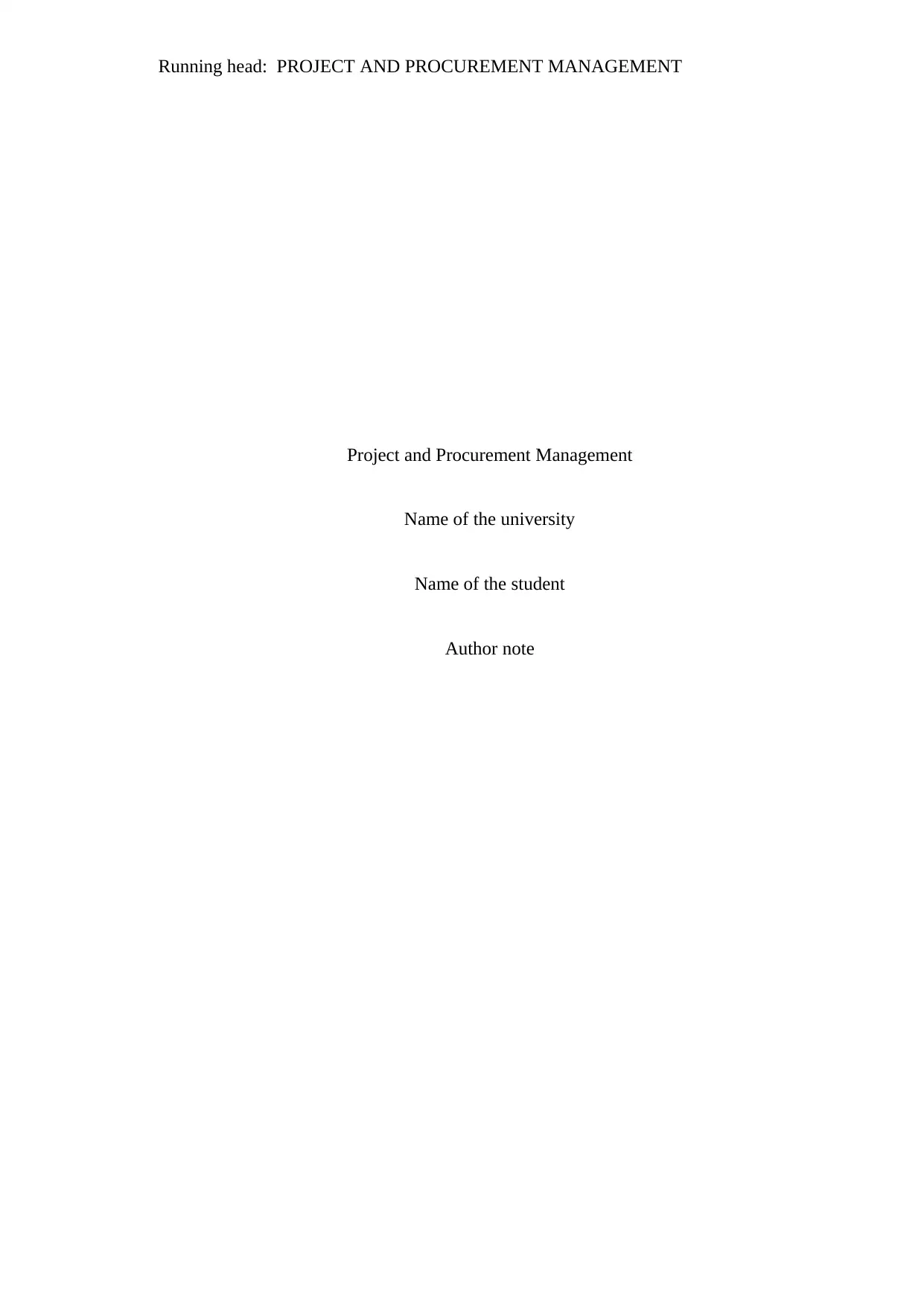
Running head: PROJECT AND PROCUREMENT MANAGEMENT
Project and Procurement Management
Name of the university
Name of the student
Author note
Project and Procurement Management
Name of the university
Name of the student
Author note
Paraphrase This Document
Need a fresh take? Get an instant paraphrase of this document with our AI Paraphraser
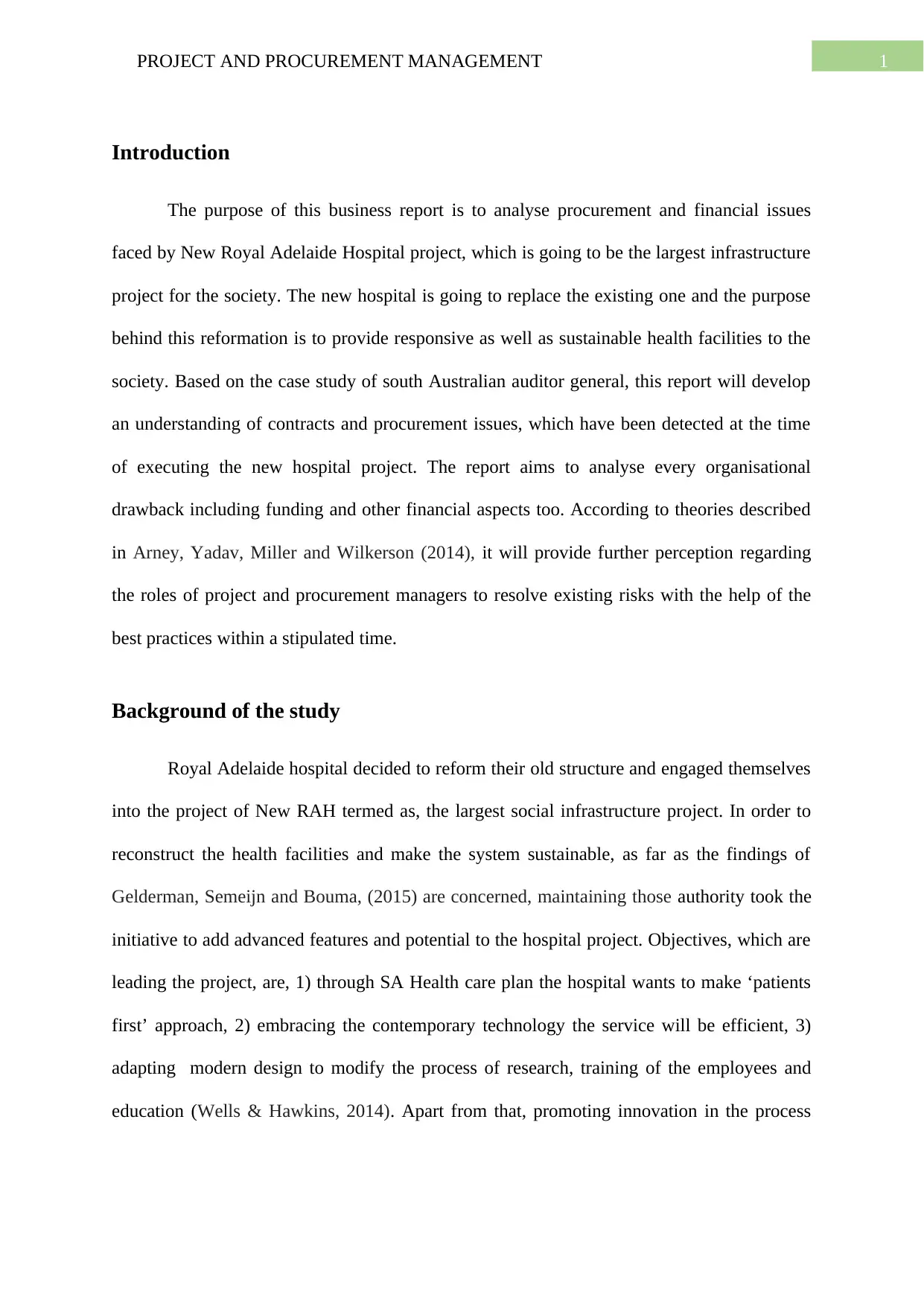
1PROJECT AND PROCUREMENT MANAGEMENT
Introduction
The purpose of this business report is to analyse procurement and financial issues
faced by New Royal Adelaide Hospital project, which is going to be the largest infrastructure
project for the society. The new hospital is going to replace the existing one and the purpose
behind this reformation is to provide responsive as well as sustainable health facilities to the
society. Based on the case study of south Australian auditor general, this report will develop
an understanding of contracts and procurement issues, which have been detected at the time
of executing the new hospital project. The report aims to analyse every organisational
drawback including funding and other financial aspects too. According to theories described
in Arney, Yadav, Miller and Wilkerson (2014), it will provide further perception regarding
the roles of project and procurement managers to resolve existing risks with the help of the
best practices within a stipulated time.
Background of the study
Royal Adelaide hospital decided to reform their old structure and engaged themselves
into the project of New RAH termed as, the largest social infrastructure project. In order to
reconstruct the health facilities and make the system sustainable, as far as the findings of
Gelderman, Semeijn and Bouma, (2015) are concerned, maintaining those authority took the
initiative to add advanced features and potential to the hospital project. Objectives, which are
leading the project, are, 1) through SA Health care plan the hospital wants to make ‘patients
first’ approach, 2) embracing the contemporary technology the service will be efficient, 3)
adapting modern design to modify the process of research, training of the employees and
education (Wells & Hawkins, 2014). Apart from that, promoting innovation in the process
Introduction
The purpose of this business report is to analyse procurement and financial issues
faced by New Royal Adelaide Hospital project, which is going to be the largest infrastructure
project for the society. The new hospital is going to replace the existing one and the purpose
behind this reformation is to provide responsive as well as sustainable health facilities to the
society. Based on the case study of south Australian auditor general, this report will develop
an understanding of contracts and procurement issues, which have been detected at the time
of executing the new hospital project. The report aims to analyse every organisational
drawback including funding and other financial aspects too. According to theories described
in Arney, Yadav, Miller and Wilkerson (2014), it will provide further perception regarding
the roles of project and procurement managers to resolve existing risks with the help of the
best practices within a stipulated time.
Background of the study
Royal Adelaide hospital decided to reform their old structure and engaged themselves
into the project of New RAH termed as, the largest social infrastructure project. In order to
reconstruct the health facilities and make the system sustainable, as far as the findings of
Gelderman, Semeijn and Bouma, (2015) are concerned, maintaining those authority took the
initiative to add advanced features and potential to the hospital project. Objectives, which are
leading the project, are, 1) through SA Health care plan the hospital wants to make ‘patients
first’ approach, 2) embracing the contemporary technology the service will be efficient, 3)
adapting modern design to modify the process of research, training of the employees and
education (Wells & Hawkins, 2014). Apart from that, promoting innovation in the process

2PROJECT AND PROCUREMENT MANAGEMENT
and an approach towards environmental sustainability by managing the waste will be some of
the major objectives of this new project (Mignone, Hosseini, Chileshe & Arashpour, 2016).
With such noble purposes when the authority started to execute the process of
reformation, they came across with issues from several sectors and felt the requirement of
improvement to avoid project risks. The findings of Burke (2013) will help the following
report to elaborate the possible areas of major improvements and role of project managers in
this scenario.
As far as the audit report is concerned, it sheds light on the objectives of this
reformation like advanced and sustainable health related services to the people of South
Australia. Establishing robust governance and appointing efficient managers, higher authority
is trying to overcome the complexity of the project. It covers the details of project budget and
delivery status and observes that while the execution whatever issues have been raised the
project managers has tried to introduce significant changes to the procedure. The following
report will concentrate on how the project can recover from existing crisis and the real status
of it.
Few areas of improvement
Issues of financial management: The budget and financial reports delivered to the
committee are needed an improvement which should consist of probable estimation
of expenditure and a detail explanation against the differences between actual and
hypothetical framework of expenses. The report should carry the ideas to process
further funding as far as future expenditure is concerned. All the areas of expenses
were not properly documented. Commitments, cost pressures and estimation of
operations still the areas of critical evaluation to fulfil target of completing tasks
and an approach towards environmental sustainability by managing the waste will be some of
the major objectives of this new project (Mignone, Hosseini, Chileshe & Arashpour, 2016).
With such noble purposes when the authority started to execute the process of
reformation, they came across with issues from several sectors and felt the requirement of
improvement to avoid project risks. The findings of Burke (2013) will help the following
report to elaborate the possible areas of major improvements and role of project managers in
this scenario.
As far as the audit report is concerned, it sheds light on the objectives of this
reformation like advanced and sustainable health related services to the people of South
Australia. Establishing robust governance and appointing efficient managers, higher authority
is trying to overcome the complexity of the project. It covers the details of project budget and
delivery status and observes that while the execution whatever issues have been raised the
project managers has tried to introduce significant changes to the procedure. The following
report will concentrate on how the project can recover from existing crisis and the real status
of it.
Few areas of improvement
Issues of financial management: The budget and financial reports delivered to the
committee are needed an improvement which should consist of probable estimation
of expenditure and a detail explanation against the differences between actual and
hypothetical framework of expenses. The report should carry the ideas to process
further funding as far as future expenditure is concerned. All the areas of expenses
were not properly documented. Commitments, cost pressures and estimation of
operations still the areas of critical evaluation to fulfil target of completing tasks
⊘ This is a preview!⊘
Do you want full access?
Subscribe today to unlock all pages.

Trusted by 1+ million students worldwide
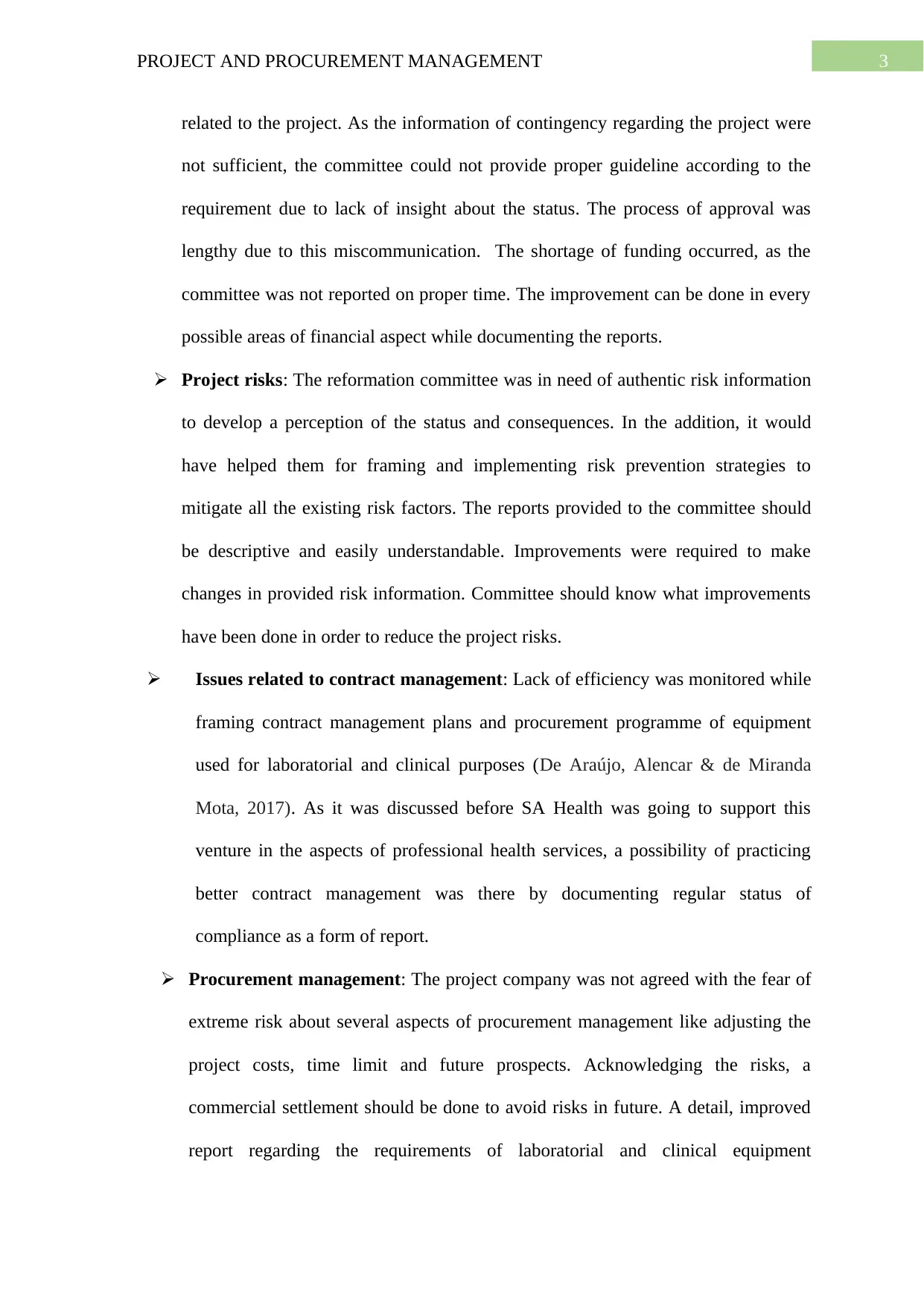
3PROJECT AND PROCUREMENT MANAGEMENT
related to the project. As the information of contingency regarding the project were
not sufficient, the committee could not provide proper guideline according to the
requirement due to lack of insight about the status. The process of approval was
lengthy due to this miscommunication. The shortage of funding occurred, as the
committee was not reported on proper time. The improvement can be done in every
possible areas of financial aspect while documenting the reports.
Project risks: The reformation committee was in need of authentic risk information
to develop a perception of the status and consequences. In the addition, it would
have helped them for framing and implementing risk prevention strategies to
mitigate all the existing risk factors. The reports provided to the committee should
be descriptive and easily understandable. Improvements were required to make
changes in provided risk information. Committee should know what improvements
have been done in order to reduce the project risks.
Issues related to contract management: Lack of efficiency was monitored while
framing contract management plans and procurement programme of equipment
used for laboratorial and clinical purposes (De Araújo, Alencar & de Miranda
Mota, 2017). As it was discussed before SA Health was going to support this
venture in the aspects of professional health services, a possibility of practicing
better contract management was there by documenting regular status of
compliance as a form of report.
Procurement management: The project company was not agreed with the fear of
extreme risk about several aspects of procurement management like adjusting the
project costs, time limit and future prospects. Acknowledging the risks, a
commercial settlement should be done to avoid risks in future. A detail, improved
report regarding the requirements of laboratorial and clinical equipment
related to the project. As the information of contingency regarding the project were
not sufficient, the committee could not provide proper guideline according to the
requirement due to lack of insight about the status. The process of approval was
lengthy due to this miscommunication. The shortage of funding occurred, as the
committee was not reported on proper time. The improvement can be done in every
possible areas of financial aspect while documenting the reports.
Project risks: The reformation committee was in need of authentic risk information
to develop a perception of the status and consequences. In the addition, it would
have helped them for framing and implementing risk prevention strategies to
mitigate all the existing risk factors. The reports provided to the committee should
be descriptive and easily understandable. Improvements were required to make
changes in provided risk information. Committee should know what improvements
have been done in order to reduce the project risks.
Issues related to contract management: Lack of efficiency was monitored while
framing contract management plans and procurement programme of equipment
used for laboratorial and clinical purposes (De Araújo, Alencar & de Miranda
Mota, 2017). As it was discussed before SA Health was going to support this
venture in the aspects of professional health services, a possibility of practicing
better contract management was there by documenting regular status of
compliance as a form of report.
Procurement management: The project company was not agreed with the fear of
extreme risk about several aspects of procurement management like adjusting the
project costs, time limit and future prospects. Acknowledging the risks, a
commercial settlement should be done to avoid risks in future. A detail, improved
report regarding the requirements of laboratorial and clinical equipment
Paraphrase This Document
Need a fresh take? Get an instant paraphrase of this document with our AI Paraphraser
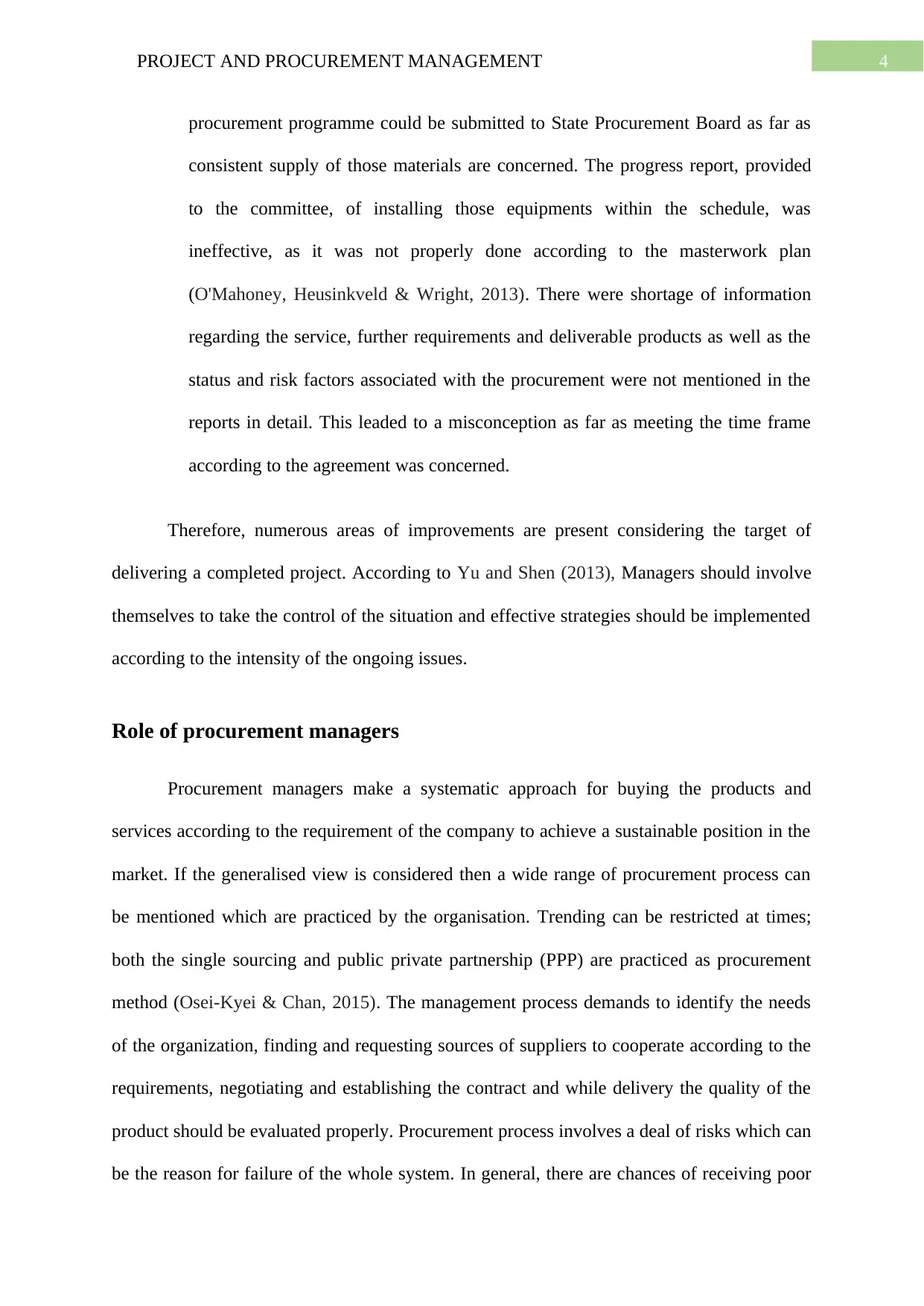
4PROJECT AND PROCUREMENT MANAGEMENT
procurement programme could be submitted to State Procurement Board as far as
consistent supply of those materials are concerned. The progress report, provided
to the committee, of installing those equipments within the schedule, was
ineffective, as it was not properly done according to the masterwork plan
(O'Mahoney, Heusinkveld & Wright, 2013). There were shortage of information
regarding the service, further requirements and deliverable products as well as the
status and risk factors associated with the procurement were not mentioned in the
reports in detail. This leaded to a misconception as far as meeting the time frame
according to the agreement was concerned.
Therefore, numerous areas of improvements are present considering the target of
delivering a completed project. According to Yu and Shen (2013), Managers should involve
themselves to take the control of the situation and effective strategies should be implemented
according to the intensity of the ongoing issues.
Role of procurement managers
Procurement managers make a systematic approach for buying the products and
services according to the requirement of the company to achieve a sustainable position in the
market. If the generalised view is considered then a wide range of procurement process can
be mentioned which are practiced by the organisation. Trending can be restricted at times;
both the single sourcing and public private partnership (PPP) are practiced as procurement
method (Osei-Kyei & Chan, 2015). The management process demands to identify the needs
of the organization, finding and requesting sources of suppliers to cooperate according to the
requirements, negotiating and establishing the contract and while delivery the quality of the
product should be evaluated properly. Procurement process involves a deal of risks which can
be the reason for failure of the whole system. In general, there are chances of receiving poor
procurement programme could be submitted to State Procurement Board as far as
consistent supply of those materials are concerned. The progress report, provided
to the committee, of installing those equipments within the schedule, was
ineffective, as it was not properly done according to the masterwork plan
(O'Mahoney, Heusinkveld & Wright, 2013). There were shortage of information
regarding the service, further requirements and deliverable products as well as the
status and risk factors associated with the procurement were not mentioned in the
reports in detail. This leaded to a misconception as far as meeting the time frame
according to the agreement was concerned.
Therefore, numerous areas of improvements are present considering the target of
delivering a completed project. According to Yu and Shen (2013), Managers should involve
themselves to take the control of the situation and effective strategies should be implemented
according to the intensity of the ongoing issues.
Role of procurement managers
Procurement managers make a systematic approach for buying the products and
services according to the requirement of the company to achieve a sustainable position in the
market. If the generalised view is considered then a wide range of procurement process can
be mentioned which are practiced by the organisation. Trending can be restricted at times;
both the single sourcing and public private partnership (PPP) are practiced as procurement
method (Osei-Kyei & Chan, 2015). The management process demands to identify the needs
of the organization, finding and requesting sources of suppliers to cooperate according to the
requirements, negotiating and establishing the contract and while delivery the quality of the
product should be evaluated properly. Procurement process involves a deal of risks which can
be the reason for failure of the whole system. In general, there are chances of receiving poor
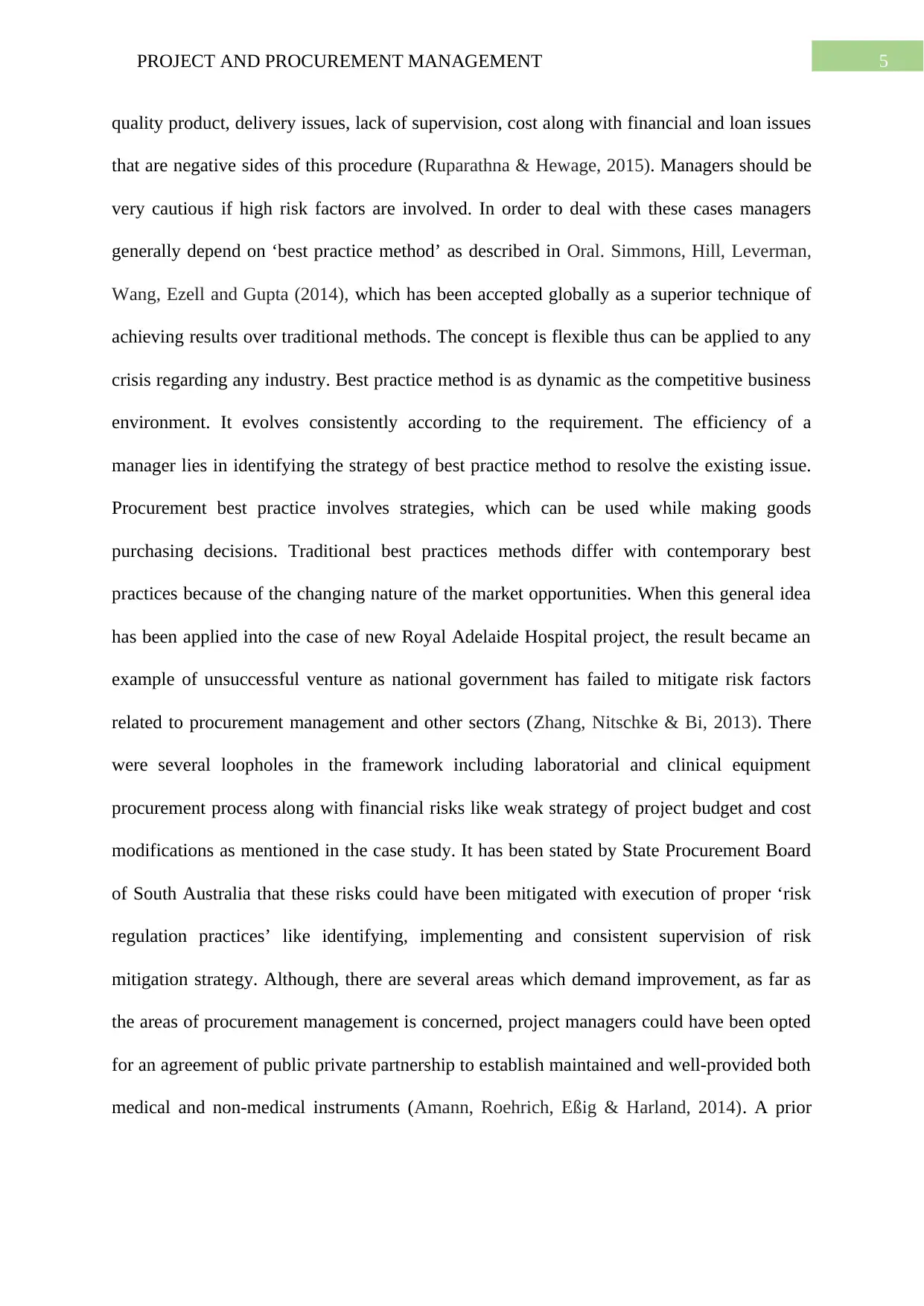
5PROJECT AND PROCUREMENT MANAGEMENT
quality product, delivery issues, lack of supervision, cost along with financial and loan issues
that are negative sides of this procedure (Ruparathna & Hewage, 2015). Managers should be
very cautious if high risk factors are involved. In order to deal with these cases managers
generally depend on ‘best practice method’ as described in Oral. Simmons, Hill, Leverman,
Wang, Ezell and Gupta (2014), which has been accepted globally as a superior technique of
achieving results over traditional methods. The concept is flexible thus can be applied to any
crisis regarding any industry. Best practice method is as dynamic as the competitive business
environment. It evolves consistently according to the requirement. The efficiency of a
manager lies in identifying the strategy of best practice method to resolve the existing issue.
Procurement best practice involves strategies, which can be used while making goods
purchasing decisions. Traditional best practices methods differ with contemporary best
practices because of the changing nature of the market opportunities. When this general idea
has been applied into the case of new Royal Adelaide Hospital project, the result became an
example of unsuccessful venture as national government has failed to mitigate risk factors
related to procurement management and other sectors (Zhang, Nitschke & Bi, 2013). There
were several loopholes in the framework including laboratorial and clinical equipment
procurement process along with financial risks like weak strategy of project budget and cost
modifications as mentioned in the case study. It has been stated by State Procurement Board
of South Australia that these risks could have been mitigated with execution of proper ‘risk
regulation practices’ like identifying, implementing and consistent supervision of risk
mitigation strategy. Although, there are several areas which demand improvement, as far as
the areas of procurement management is concerned, project managers could have been opted
for an agreement of public private partnership to establish maintained and well-provided both
medical and non-medical instruments (Amann, Roehrich, Eßig & Harland, 2014). A prior
quality product, delivery issues, lack of supervision, cost along with financial and loan issues
that are negative sides of this procedure (Ruparathna & Hewage, 2015). Managers should be
very cautious if high risk factors are involved. In order to deal with these cases managers
generally depend on ‘best practice method’ as described in Oral. Simmons, Hill, Leverman,
Wang, Ezell and Gupta (2014), which has been accepted globally as a superior technique of
achieving results over traditional methods. The concept is flexible thus can be applied to any
crisis regarding any industry. Best practice method is as dynamic as the competitive business
environment. It evolves consistently according to the requirement. The efficiency of a
manager lies in identifying the strategy of best practice method to resolve the existing issue.
Procurement best practice involves strategies, which can be used while making goods
purchasing decisions. Traditional best practices methods differ with contemporary best
practices because of the changing nature of the market opportunities. When this general idea
has been applied into the case of new Royal Adelaide Hospital project, the result became an
example of unsuccessful venture as national government has failed to mitigate risk factors
related to procurement management and other sectors (Zhang, Nitschke & Bi, 2013). There
were several loopholes in the framework including laboratorial and clinical equipment
procurement process along with financial risks like weak strategy of project budget and cost
modifications as mentioned in the case study. It has been stated by State Procurement Board
of South Australia that these risks could have been mitigated with execution of proper ‘risk
regulation practices’ like identifying, implementing and consistent supervision of risk
mitigation strategy. Although, there are several areas which demand improvement, as far as
the areas of procurement management is concerned, project managers could have been opted
for an agreement of public private partnership to establish maintained and well-provided both
medical and non-medical instruments (Amann, Roehrich, Eßig & Harland, 2014). A prior
⊘ This is a preview!⊘
Do you want full access?
Subscribe today to unlock all pages.

Trusted by 1+ million students worldwide
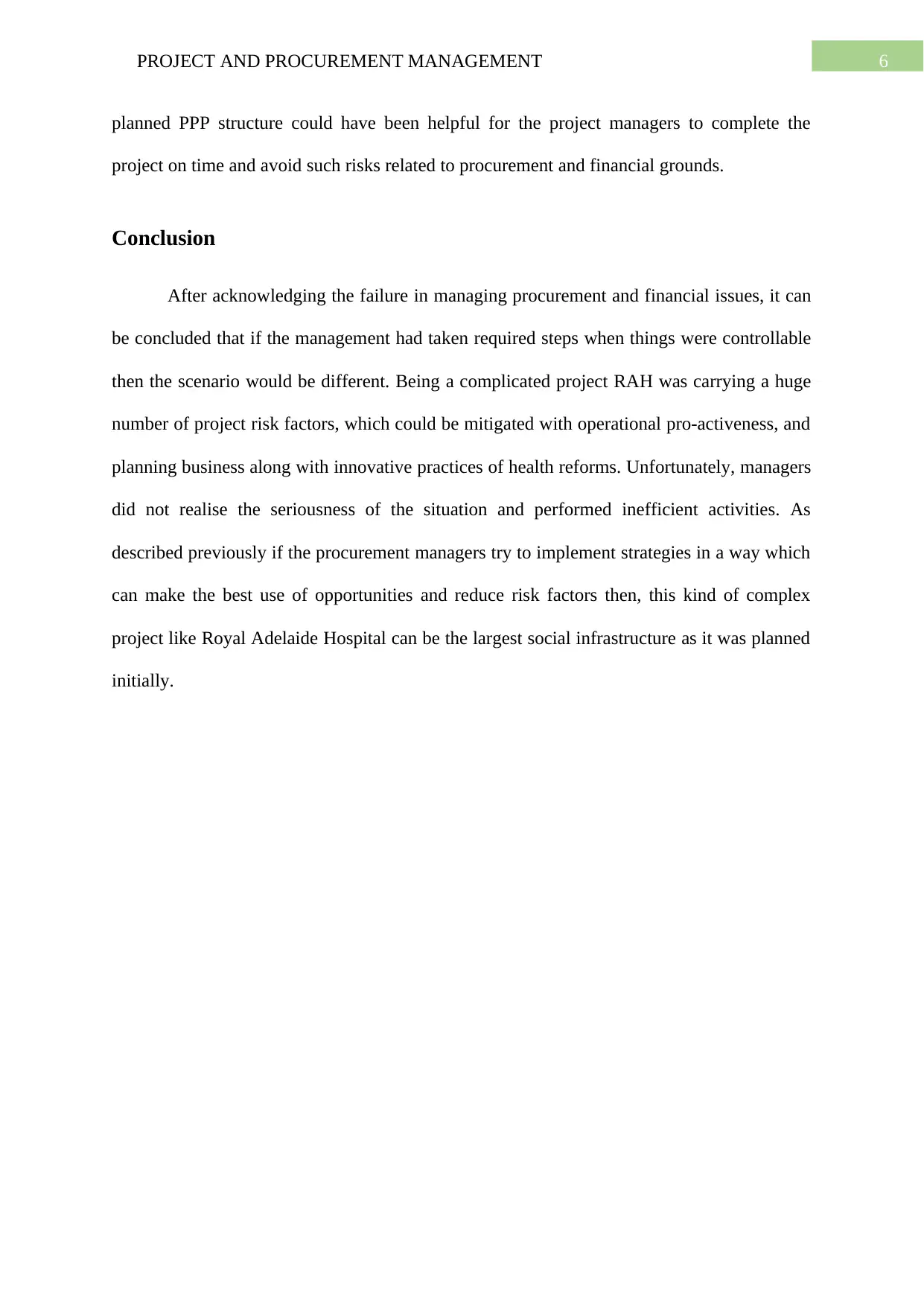
6PROJECT AND PROCUREMENT MANAGEMENT
planned PPP structure could have been helpful for the project managers to complete the
project on time and avoid such risks related to procurement and financial grounds.
Conclusion
After acknowledging the failure in managing procurement and financial issues, it can
be concluded that if the management had taken required steps when things were controllable
then the scenario would be different. Being a complicated project RAH was carrying a huge
number of project risk factors, which could be mitigated with operational pro-activeness, and
planning business along with innovative practices of health reforms. Unfortunately, managers
did not realise the seriousness of the situation and performed inefficient activities. As
described previously if the procurement managers try to implement strategies in a way which
can make the best use of opportunities and reduce risk factors then, this kind of complex
project like Royal Adelaide Hospital can be the largest social infrastructure as it was planned
initially.
planned PPP structure could have been helpful for the project managers to complete the
project on time and avoid such risks related to procurement and financial grounds.
Conclusion
After acknowledging the failure in managing procurement and financial issues, it can
be concluded that if the management had taken required steps when things were controllable
then the scenario would be different. Being a complicated project RAH was carrying a huge
number of project risk factors, which could be mitigated with operational pro-activeness, and
planning business along with innovative practices of health reforms. Unfortunately, managers
did not realise the seriousness of the situation and performed inefficient activities. As
described previously if the procurement managers try to implement strategies in a way which
can make the best use of opportunities and reduce risk factors then, this kind of complex
project like Royal Adelaide Hospital can be the largest social infrastructure as it was planned
initially.
Paraphrase This Document
Need a fresh take? Get an instant paraphrase of this document with our AI Paraphraser

7PROJECT AND PROCUREMENT MANAGEMENT
References
Amann, M., K. Roehrich, J., Eßig, M., & Harland, C. (2014). Driving sustainable supply
chain management in the public sector: The importance of public procurement in the
European Union. Supply Chain Management: An International Journal, 19(3), 351-
366.
Arney, L., Yadav, P., Miller, R., & Wilkerson, T. (2014). Strategic contracting practices to
improve procurement of health commodities. Global Health: Science and
Practice, 2(3), 295-306.
Burke, R. (2013). Project management: planning and control techniques. New Jersey, USA.
De Araújo, M. C. B., Alencar, L. H., & de Miranda Mota, C. M. (2017). Project procurement
management: A structured literature review. International Journal of Project
Management, 35(3), 353-377.
Gelderman, C. J., Semeijn, J., & Bouma, F. (2015). Implementing sustainability in public
procurement: The limited role of procurement managers and party-political
executives. Journal of Public Procurement, 15(1), 66-92.
Mignone, G., Hosseini, M. R., Chileshe, N., & Arashpour, M. (2016). Enhancing
collaboration in BIM-based construction networks through organisational
discontinuity theory: a case study of the new Royal Adelaide Hospital. Architectural
Engineering and Design Management, 12(5), 333-352.
O'Mahoney, J., Heusinkveld, S., & Wright, C. (2013). Commodifying the commodifiers: the
impact of procurement on management knowledge. Journal of Management
Studies, 50(2), 204-235.
References
Amann, M., K. Roehrich, J., Eßig, M., & Harland, C. (2014). Driving sustainable supply
chain management in the public sector: The importance of public procurement in the
European Union. Supply Chain Management: An International Journal, 19(3), 351-
366.
Arney, L., Yadav, P., Miller, R., & Wilkerson, T. (2014). Strategic contracting practices to
improve procurement of health commodities. Global Health: Science and
Practice, 2(3), 295-306.
Burke, R. (2013). Project management: planning and control techniques. New Jersey, USA.
De Araújo, M. C. B., Alencar, L. H., & de Miranda Mota, C. M. (2017). Project procurement
management: A structured literature review. International Journal of Project
Management, 35(3), 353-377.
Gelderman, C. J., Semeijn, J., & Bouma, F. (2015). Implementing sustainability in public
procurement: The limited role of procurement managers and party-political
executives. Journal of Public Procurement, 15(1), 66-92.
Mignone, G., Hosseini, M. R., Chileshe, N., & Arashpour, M. (2016). Enhancing
collaboration in BIM-based construction networks through organisational
discontinuity theory: a case study of the new Royal Adelaide Hospital. Architectural
Engineering and Design Management, 12(5), 333-352.
O'Mahoney, J., Heusinkveld, S., & Wright, C. (2013). Commodifying the commodifiers: the
impact of procurement on management knowledge. Journal of Management
Studies, 50(2), 204-235.
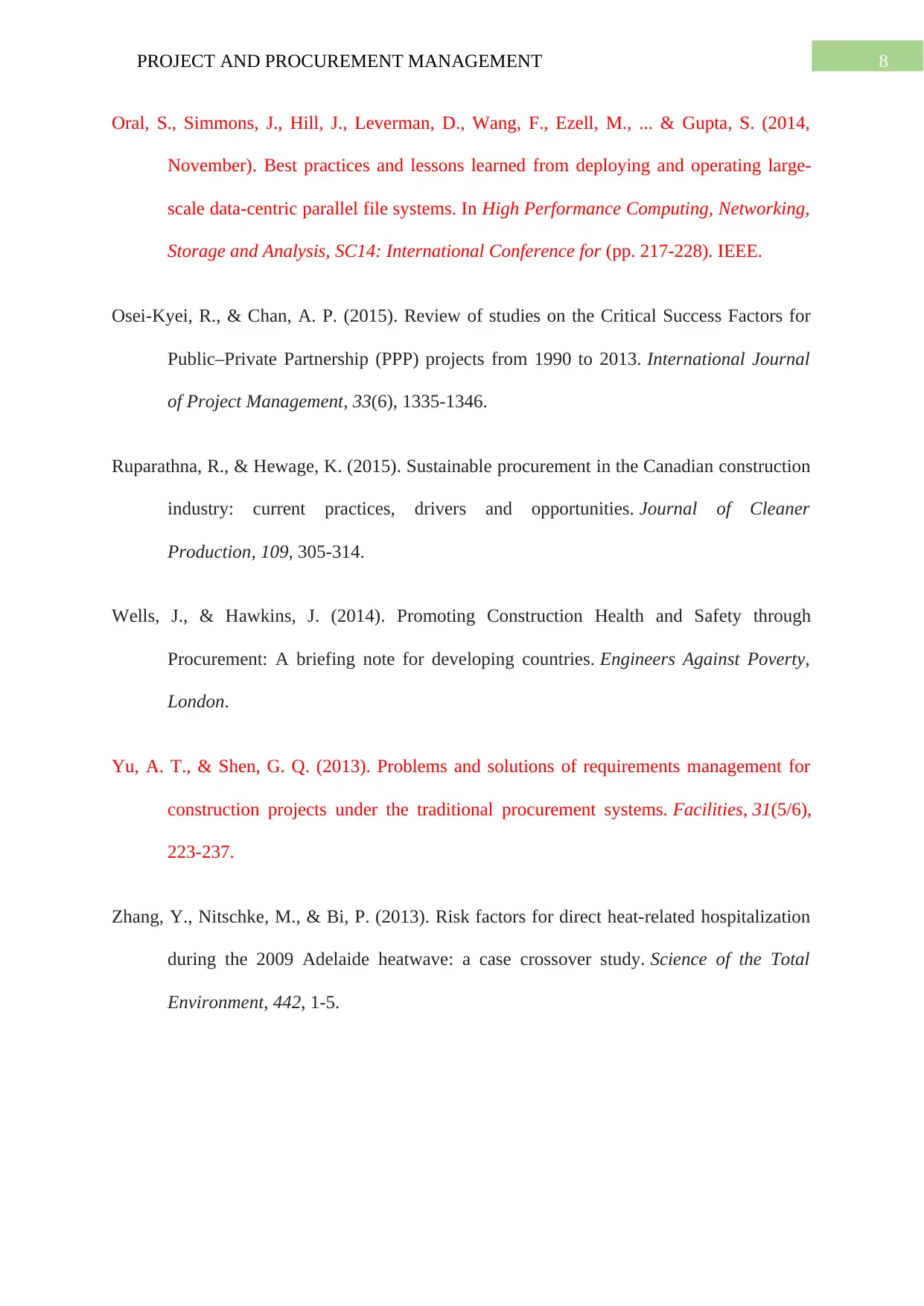
8PROJECT AND PROCUREMENT MANAGEMENT
Oral, S., Simmons, J., Hill, J., Leverman, D., Wang, F., Ezell, M., ... & Gupta, S. (2014,
November). Best practices and lessons learned from deploying and operating large-
scale data-centric parallel file systems. In High Performance Computing, Networking,
Storage and Analysis, SC14: International Conference for (pp. 217-228). IEEE.
Osei-Kyei, R., & Chan, A. P. (2015). Review of studies on the Critical Success Factors for
Public–Private Partnership (PPP) projects from 1990 to 2013. International Journal
of Project Management, 33(6), 1335-1346.
Ruparathna, R., & Hewage, K. (2015). Sustainable procurement in the Canadian construction
industry: current practices, drivers and opportunities. Journal of Cleaner
Production, 109, 305-314.
Wells, J., & Hawkins, J. (2014). Promoting Construction Health and Safety through
Procurement: A briefing note for developing countries. Engineers Against Poverty,
London.
Yu, A. T., & Shen, G. Q. (2013). Problems and solutions of requirements management for
construction projects under the traditional procurement systems. Facilities, 31(5/6),
223-237.
Zhang, Y., Nitschke, M., & Bi, P. (2013). Risk factors for direct heat-related hospitalization
during the 2009 Adelaide heatwave: a case crossover study. Science of the Total
Environment, 442, 1-5.
Oral, S., Simmons, J., Hill, J., Leverman, D., Wang, F., Ezell, M., ... & Gupta, S. (2014,
November). Best practices and lessons learned from deploying and operating large-
scale data-centric parallel file systems. In High Performance Computing, Networking,
Storage and Analysis, SC14: International Conference for (pp. 217-228). IEEE.
Osei-Kyei, R., & Chan, A. P. (2015). Review of studies on the Critical Success Factors for
Public–Private Partnership (PPP) projects from 1990 to 2013. International Journal
of Project Management, 33(6), 1335-1346.
Ruparathna, R., & Hewage, K. (2015). Sustainable procurement in the Canadian construction
industry: current practices, drivers and opportunities. Journal of Cleaner
Production, 109, 305-314.
Wells, J., & Hawkins, J. (2014). Promoting Construction Health and Safety through
Procurement: A briefing note for developing countries. Engineers Against Poverty,
London.
Yu, A. T., & Shen, G. Q. (2013). Problems and solutions of requirements management for
construction projects under the traditional procurement systems. Facilities, 31(5/6),
223-237.
Zhang, Y., Nitschke, M., & Bi, P. (2013). Risk factors for direct heat-related hospitalization
during the 2009 Adelaide heatwave: a case crossover study. Science of the Total
Environment, 442, 1-5.
⊘ This is a preview!⊘
Do you want full access?
Subscribe today to unlock all pages.

Trusted by 1+ million students worldwide
1 out of 9
Related Documents
Your All-in-One AI-Powered Toolkit for Academic Success.
+13062052269
info@desklib.com
Available 24*7 on WhatsApp / Email
![[object Object]](/_next/static/media/star-bottom.7253800d.svg)
Unlock your academic potential
Copyright © 2020–2025 A2Z Services. All Rights Reserved. Developed and managed by ZUCOL.





